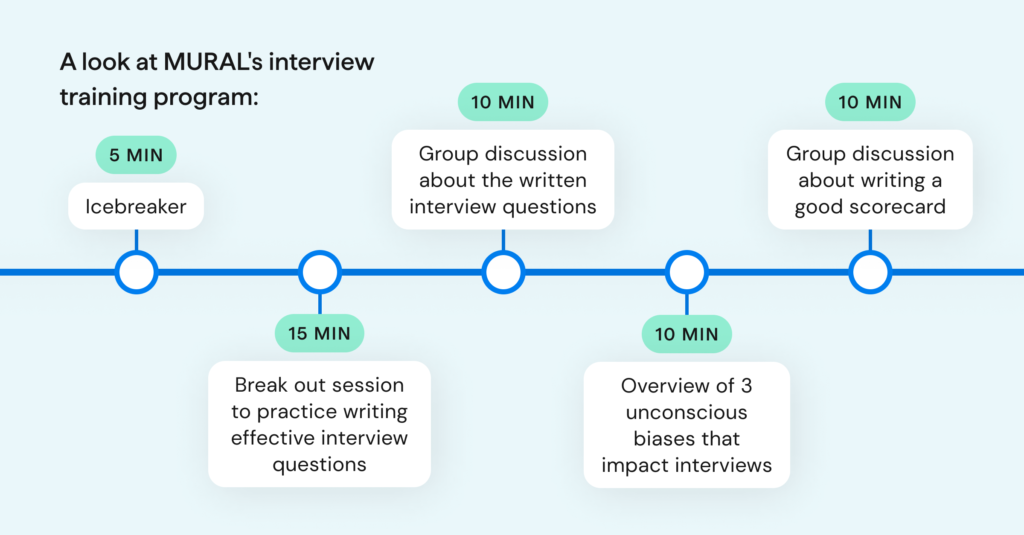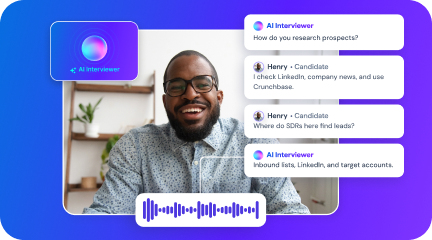Unstructured interviews, low offer acceptance rates, inefficient hiring processes. If you’re experiencing any of these obstacles, that may be a sign that it’s time to develop (or update) an interview training program.
With interview training, you can create a consistent interview process that provides candidates with a great experience and eliminates unnecessary interview rounds.
Whether you’re starting from scratch or making some improvements, we’re here to help. We spoke with four phenomenal talent acquisition teams at Nextdoor, Clipboard Health, MURAL, and Labelbox to get the scoop on their interview training programs.
Read on to find out how these top teams approach interview training, including:
- What topics they cover
- Who they train
- The best practices and tips they’ve learned along the way
4 talent acquisition teams leading the way in interview training
Nextdoor
Nextdoor (NYSE: KIND) is where you connect to the neighborhoods that matter to you so you can belong. Kindness is the San Francisco-based company’s core to its purpose: to cultivate a kinder world where everyone has a neighborhood they can rely on.
Neighbors around the world turn to Nextdoor daily to receive trusted information, give and get help, get things done, and build real-world connections with those nearby — neighbors, businesses, and public services. Today, neighbors rely on Nextdoor in more than 295,000 neighborhoods across 11 countries and in nearly 1 in 3 U.S. households.
Nextdoor’s approach to interview training
To build an interview training program, Nextdoor’s talent acquisition team began with a simple question. How can we equip everyone involved in interviewing with the tools to make the best use of their time interviewing? The answer: customize trainings tailored to the needs of the different interview participants: hiring managers, interviewers, and recruiters.
Each of these groups plays a different role in the interview process, so a single, generalized training template wouldn’t properly cover the details they need. Instead, the talent acquisition team segmented training for the audiences so that participants could hone the appropriate skills and maximize their time with candidates.
Nextdoor’s focus on company values
The training program’s curriculum design flows from a combination of Nextdoor’s leadership principles and company values: earn trust every day, invest in community, customer obsessed, think big, experiment and learn quickly, and act like an owner.
The company values inform both who they hire and how they want candidates and interviewers to experience the interview process – creating a safe space of mutual sharing, where both parties have an opportunity to preview what it would be like to work with one another.
Nextdoor’s leadership principles have themes, including empowerment and autonomy, from which much of the hiring manager training flow. So when designing their curriculums, Tony Castellanos, Head of Talent & Compensation at Nextdoor, and his team sought to authentically extend from these core concepts.
For hiring managers, they designed an all-encompassing, comprehensive training. It empowers hiring managers by equipping them with skills essential for end-to-end recruiting success, such as:
- Networking and building candidate pipeline
- Fostering relationships
- Designing an effective evaluation process
- Making effective hiring decisions
Tony says, “Company-wide, we focus on enabling and accelerating Nextdoor’s leaders and teams. Our goal for this training was to provide hiring managers with the foundations needed to develop and grow their teams in a tight talent market.”
For interviewers, the talent team wanted to go beyond the typical practice of focusing only on candidate experience, though that is still a primary module in their training. Instead, they prioritized designing content that helps participants build strong interviewing skills and teaches them how to elicit the appropriate signals in the limited time they have with candidates.
Nextdoor’s interview training best practices
Nextdoor’s talent acquisition team believes structure and consistency are the keys to running better, more effective interviews.
“The greatest catalyst for introducing interview training was recognizing the level of inconsistency that existed in both depth of interviews and candidate experience across the company,” says Tony. “This impacted hiring decisions and recruiting efficiency in ways that would ultimately cripple scaling efforts if left unaddressed.”
“To ensure we hire people who understand and hopefully align with our core values, we ask interviewers to share their personal stories about Nextdoor as a way to honestly portray who we are. It allows candidates to opt-in if this is an environment that resonates. We also assign interviewers with a single, specific competency to evaluate for to improve focus in the conversation. That clarity prevents wasting time, which allows real sharing to happen in the first place.”
Clipboard Health
Clipboard Health uses technology to connect nurses with nursing facilities.
Clipboard Health’s approach to interview training
Clipboard Health offers an intensive interview training program for its team of engineers. The program focuses on helping new engineer interviewers evaluate take-home tests and build interviewing skills.
Take-home tests are a key way for the engineering team to understand a candidate’s skills and ability to problem solve. The tests are evaluated and graded using specific rubrics. During interview training, new interviewers learn about the rubrics and how to grade candidates consistently. As interviewers begin to grade tests, engineers, managers, and team leads audit the grading to ensure the tests are evaluated accurately.
Clipboard Health’s focus on real interview moments
To teach new interviewers how to evaluate candidates in an interview, Clipboard Health incorporates BrightHire interview recordings into interview training. New interviewers watch examples of good, bad, and borderline interviews from BrightHire that skilled interviewers select.
After watching the recordings, interviewers participate in two reverse shadowing sessions. In these sessions, the interviewers conduct an interview alongside a skilled interviewer. The experienced interviewer can jump in as needed and provide feedback to the interviewer in training. Once they complete this step, participants officially become full-time interviewers.
Clipboard Health’s interview training best practices
Clipboard Health’s team believes learning how to become a great interviewer doesn’t have to stop at the end of the training program. Once an interviewer begins taking part in interviews, the team audits the conversations and provides one-on-one coaching when needed.
“We ask managers to audit interviews by watching BrightHire videos,” says Hannah Kim, Chief of Staff at Clipboard Health. “Watching the interview recordings helps us ensure that if interviewers aren’t performing at the standards we want, we can provide them with feedback.”
MURAL
MURAL is a digital workspace designed to support creative visual collaboration that’s used by over 90% of the Fortune 100.
MURAL’s approach to interview training
MURAL’s talent acquisition team has built a comprehensive, engaging interview training program using the company’s interactive workspace. The training covers everything from writing effective behavioral and situational interview questions to understanding the most common unconscious biases that can impact interviews.
The training includes:

MURAL’s interview training best practices
Interview training isn’t a set-it-and-forget-it program for MURAL’s talent acquisition team. They’re constantly seeking ways to improve, looking for gaps in the program, and supplementing with additional resources.
“Along with our interview training program, our talent coordination team created a MURAL hiring process playbook,” says Meghan Munzel, Global Talent Acquisition Manager at MURAL. “The playbook walks you through what you need to know about our hiring process from start to finish.”
“The playbook provides guidance for job description templates, kickoff documents, question banks, hiring tools, interviews, and debriefs. It supports our interview training by helping answer any questions and providing additional guidance to our team of interviewers.”
Labelbox
Labelbox is an all-in-one solution for AI and machine learning training data.
Labelbox’s approach to interview training
Labelbox takes a three-pronged approach to interview training. The program includes watching recorded sessions, participating in shadow interviews, and taking part in reverse shadowing.
The recorded sessions align with Labelbox’s three types of interviews: mission and values, role-specific, and topgrading. The recorded sessions feature the best interviewers in the three categories. The videos share how to structure conversations, ask the right questions, and dig deeper with follow-up questions.
Along the recordings, Labelbox’s recruiting team also offers live refresher sessions for mission and values and topgrading interviews. These are more interactive, with breakout sessions where interviewees can provide feedback to each other, role play, and build their interviewing skills.
Initially, when they launched the program, the recruiting team recommended all interviewers take it. But now, training is only required once you’ve been at the company for six months, so interviewers have a chance to develop a good understanding of the company, product, and culture.
Labelbox’s focus on two-way assessment
One of the biggest lessons the recruiting team emphasizes in training is the importance of transparency, structured interviewing, and continuous feedback.
“Interviewing is a two-way street,” says Elena Stefanopol, Director of Recruiting at Labelbox. “Candidates are also assessing us. This gives us an opportunity to showcase our culture and offer them as much context as we can, so they can make an informed decision for themselves.”
By providing candidates with a view into Labelbox and its culture, candidates can understand what’s expected and how they can be successful in the role.
Labelbox’s interview training best practices
A successful interview training program is never static. It evolves and grows based on candidates’ interview feedback.
“Our goal is to offer a consistent, positive experience to our candidates and our interviewers,” says Elena. “We implemented a candidate experience survey to identify areas that could use some more TLC. This feedback helps us ensure we offer a consistent experience, regardless of who’s the interviewer.”
Create an A+ interview training program
Ready to build your interview training program? Download our interview training template to access a comprehensive presentation deck that includes:
- 62-slide presentation deck that covers unconscious biases, candidate experience, interviews, and debriefs
- 12 proven activities, breakout sessions, and group discussions
- A comprehensive facilitation guide that walks you step-by-step through presenting the training session









